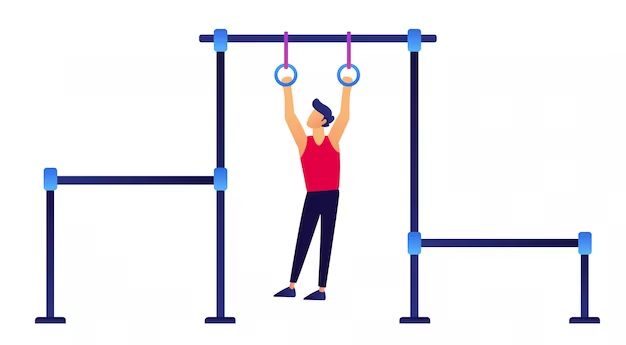A joist mounted pull-up bar is an excellent way to add a pull-up bar to your home gym without having to install a large, standalone pull-up rack. Joist mounting allows you to securely attach a pull-up bar between two ceiling joists, providing a solid base for doing pull-ups, chin-ups, and hanging knee raises. With some basic DIY skills and the right materials, installing a joist mounted pull-up bar is a straightforward weekend project.
Page Contents
Benefits of a Joist Mounted Pull-Up Bar
Here are some of the key benefits of installing a joist mounted pull-up bar in your home gym:
- Takes up very little space – Only requires room between two joists, perfect for small home gyms
- Very secure when properly installed – Capable of supporting over 300 lbs
- Much more affordable than a full pull-up rack
- Can be installed at different heights to accommodate different exercises
- Gives you a dedicated vertical pulling movement in your workout
What You’ll Need
Installing a joist mounted pull-up bar requires some common tools and hardware that can be purchased at your local hardware store. Here’s an overview of what you’ll need:
- Pull-up bar – Either a dedicated joist mount bar or a standard pull-up bar
- Fasteners – 3/8″ x 3″ lag screws and washers
- Drill with various drill bits
- Socket wrench
- Stud finder
- Step ladder
- Safety equipment – Gloves, eye protection, hard hat (optional)
You’ll also need to purchase or build mounting brackets to attach the pull-up bar securely between the joists. For a simple DIY bracket, a 2×4 or 2×6 piece of wood cut to length will suffice.
Choosing the Right Location
Properly locating your joist mounted pull-up bar is crucial for both safety and convenience. Here are some tips for choosing the right location:
- Pick an area with adequate clearance – Make sure you’ll have enough overhead space for different grips and exercises like leg raises
- Minimum joist spacing of 16″ – 24″ is ideal
- Avoid plumbing or electrical wiring between the joists
- Central location for ease of access and visibility
- High traffic areas should be avoided
- Consider mounting next to a wall for added stability
Measure the joist spacing in candidate locations and select an area that meets your needs. Most standard pull-up bars designed for joist mounting are 42-48″ long.
How to Mount a Pull-Up Bar Between Joists
Once you have gathered the necessary tools and materials and selected an appropriate location, you’re ready to install the pull-up bar. Follow these steps:
- Measure and mark the center point between the two joists to position the pull-up bar.
- Cut mounting brackets (2×4 or 2×6 boards) to fit snugly between the joists.
- Pre-drill holes in the ends of the mounting brackets for lag screws.
- Use a stud finder to locate the joists and mark where screws will go.
- Drill pilot holes in the joists for each lag screw using a 3/16″ drill bit.
- Attach mounting brackets to joists using 3/8″ x 3″ lag screws and washers.
- Attach the pull-up bar securely to the mounting brackets through pre-drilled holes.
- Check that all hardware is tight and the bar is centered before use.
Be sure to attach the bar with the proper side up for gripping. Mounting it upside down can result in an unsafe setup. Follow all safety precautions when working at height on a ladder.
Safety Tips
When properly installed, a joist mounted pull-up bar is extremely sturdy and safe. However, there are some precautions you should take:
- Carefully inspect ceiling structure before installation
- Only mount to solid wood joists, not trusses
- Use appropriate lag screws and washers
- Pre-drill appropriate pilot holes
- Double check all hardware is tight
- Test thoroughly before use and check for signs of loosening
- Weight capacity is 300-400 lbs depending on joist quality
- Only one person should use at a time
Visually inspecting the pull-up bar each time before use is recommended. Do not exercise on the bar if you notice any loosening or damage.
Exercise Ideas
A joist mounted pull-up bar is designed primarily for bodyweight vertical pulling movements. Here are some great exercise options:
Pull-Ups
Pull-ups are the classic vertical pulling exercise. Grip the bar with palms facing away and pull yourself up until your chin clears the bar.
Chin-Ups
Chin-ups use an underhand grip with palms facing you. Focus on pulling your chest or chin up to the bar.
Neutral Grip Pull-Ups
Use a parallel/neutral palm facing grip. Great for people with shoulder issues.
Commando Pull-Ups
Hang from just one side of the bar and pull up with one arm. Work each arm independently.
Leg Raises
Raise your straight legs up to hip height while maintaining a tight core. Can also do knee raises.
Hanging Knee Raises
Bring your knees up to your chest while keeping legs bent at 90 degrees and core braced.
Windshield Wipers
Swing legs side to side in a controlled motion to work obliques.
Conclusion
Installing a pull-up bar between ceiling joists is a simple project that can greatly expand your at-home workout options. With proper joists, hardware, and installation technique, a joist mounted bar can be an extremely sturdy and safe piece of exercise equipment. Just be sure to follow all safety precautions and inspect thoroughly before each use. A quality joist mounted pull-up bar provides an effective way to incorporate intense vertical pulling exercises into your home gym routine.
